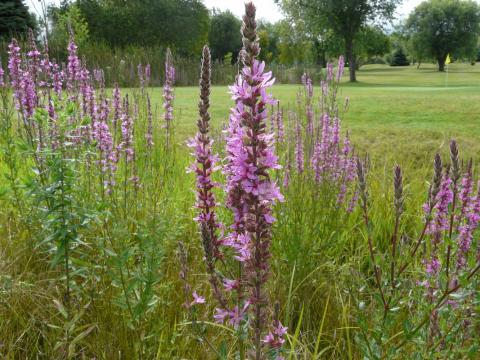Invasive in the Spotlight: Purple Loosestrife

With its striking flowers, purple loosestrife (Lythrum salicaria) is a beautiful menace in wetland habitats. Purple loosestrife is a perennial invasive plant that was introduced to North America from Europe via seeds in ships’ ballast. Horticulturists subsequently propagated it as an ornamental bedding plant.
Purple loosestrife can be identified by its oppositely arranged, downy, smooth edged leaves along the stem, as well as by its showy, purple flowers that bloom from mid-July through early August.
Purple loosestrife is usually found in sunny, wet areas, such as the edges of ponds and lakes, drainage ditches, marshes, and wetlands. It is considered a serious threat to these habitats, because once it becomes established, it quickly displaces native species and reduces overall plant and animal diversity. Purple loosestrife spreads primarily by seed.

Control
The best time to manage purple loosestrife is when it is flowering, because that is when it is easiest to recognize. Small or new infestations can be hand-pulled or dug. Hand-pulling is best when plants are young. As plants mature they develop an extensive perennial root system. Larger older plants are more easily removed with a shovel or digging fork. Before digging, remove flower heads to prevent spreading any seed inadvertently. Cut the flower heads over a bucket or bag to collect seed. Plants can also be cut to the ground before they set seed. This treatment won’t kill the plants, but it will slow their spread. Dispose of all plant parts - do not put them on the compost pile.
If you have purple loosestrife on your own property in a dry upland area, it can be controlled with an approved herbicide. Selectively spray individuals to avoid killing non-target plants. Do not spray plants that are growing in or near the water.
Purple loosestrife is also being biologically controlled in some parts of New Hampshire by two species of introduced leaf-eating beetles.

Native Alternative
Purple loosestrife should never be purchased, planted, or transplanted. If you need a replacement for your garden, try planting an alternative non-invasive species such as blazing star (Liatris spp.).
Got questions? Master Gardeners provide practical help finding answers to your questions through the Ask UNH Extension Infoline. Call toll free at 1-877-398-4769, Monday to Friday, 9 a.m. to 2 p.m., or e-mail us at answers@unh.edu.
Related Resource(s)
Do you love learning about stuff like this?
SUBSCRIBE TO Granite State Gardening newsletter
Got questions? The UNH Extension Yard and Garden Infoline offers practical help finding answers for your yard and garden questions.
Call toll free at 1-877-398-4769, Monday to Friday, 9 a.m. to 2 p.m., or fill out webform.
